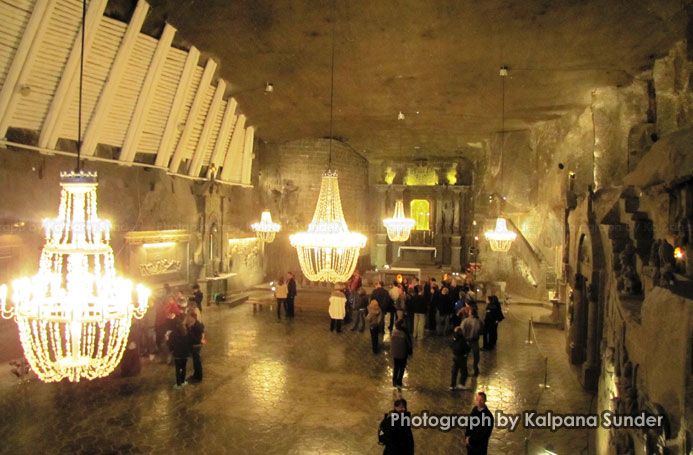
I ask our lanky Polish guide Marek Klinowicz: “For how long have you been working here?” and he smiles: “About 200 years... You see, salt is a good preservative!” Laughing, we follow him into the subterranean world of the Wieliczka Salt Mines near Krakow, Poland. We go down the vertiginous 380 steps to the first level. The mines date back to the 13th Century with over 200 km of galleries from a depth of 64 mt to 135 mt on the tourist trail.
Mining rock salt was a dangerous job, and this made miners religious. In their spare time, many of them created works of art, including chapels, in rock salt. We walk through miles of timber structures supporting the mines and painted white to help the miners find their way in the dark. This is a fantasy world straight out of a Jules Verne novel — spooky, dimly-lit passages, stalactites and stalagmites made of salt (dull grey, reminiscent of unpolished granite), crystal clear pools of water, mini-lakes of brine and statues in alcoves.
There is an impressive statue of Copernicus (fascinatingly, he's visited the mine!) carved out of rock salt with the sun in his hand. There are life-sized tableaus of horses as well as wooden contraptions to carry salt to the surface. The humidity in the caverns, however, has eroded the features in several statues. Some displays show the dangers that the miners had to face before adequate ventilation systems evolved — they had to crawl on the ground and burn the salt petre accumulated in the ceilings with a long torch. The reward for such a dangerous job — an extra bag of salt!
In the Janowice Chamber, we see the tableau of Princess Kinga based on a 700-year-old legend — a Hungarian princess, Kinga was marrying into the royal family of Poland and got a salt mine as her dowry. She cast her engagement ring into the salt mine. When she was on the way to Krakow, she told her people to dig a well, and instead of water they found her ring in a lump of salt! Ever since, she has been the patron of salt miners. At the Weimar gallery with a sparkling underground lake, viewing platforms and steps, we witness a mini son et lumière show. Accompanied by Chopin's music, the Warden (an imaginary protective angel) appears alongside carts filled with salt. The miners used to invent such people who took care of their safety and appeared whenever they were at risk, to warn them about the danger!
The pièce de résistance is the Chapel of St. Kinga made over 67 years — an elegant ball room where everything is made of yes, salt! On the ceiling are five chandeliers strung with hand-cut crystals of salt. On the wall is a wealth of rock salt images and bas reliefs — starting from a dramatic Last Supper and the Wedding of Cana to images of St. Kinga and even Pope John Paul II. This was not about people relieving their boredom — it looks more like an act of devotion. Some figures are made of translucent salt and lit up on the inside. The floors are made of rock salt too; and polished by the hundreds of people, who walk here every day, says Marek! And, the miners did not create just religious stuff: their sense of play is evident from the scene out of Snow White and the Seven Dwarfs, illuminated by coloured lights. Gnomes were the good luck charms of the miners. Legend has it that when the miners were tired and needed to nap, these loveable sprites helped in their work!
The Wieliczka Mine has a therapeutic aspect to it too: the micro climate in the chambers is good for allergies, asthma and respiratory ailments and an overnight stay at the Treatment Centre here could be just what the doctor ordered! There are many chambers here — where jazz concerts (because of the excellent acoustics), weddings, conferences and banquets are held.
One of the chambers has an elevator for the physically challenged, and souvenir shops selling — not salt — the famous Baltic amber jewellery. We have lunch at the deepest underground restaurant in the world with some Polish smoked cheese and potato pancakes. Just as I shudder at the thought of ascending the steps after a delicious meal, Marek delivers a piece of good news — the return journey is on a shaft elevator. (By the way, the mines are so gargantuan that at the end of our three-hour tour, we've seen less than three per cent of the total passages!) It's dark and eerie as the old cramped elevator cage rockets us to the surface in a few seconds. I look at the sunshine with new eyes — like a visionless man gifted sight.
Published in The Hindu Metro Plus, Chennai, 2010

